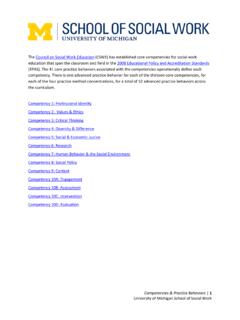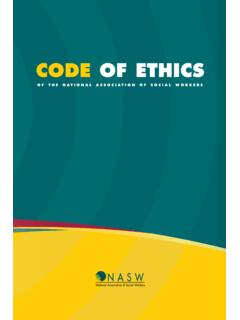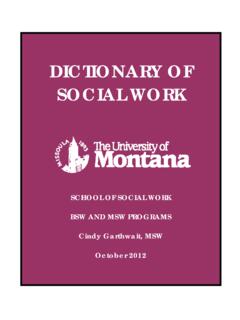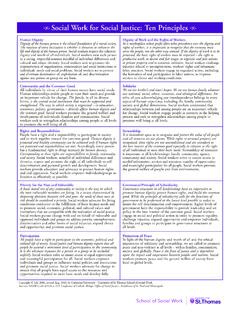Transcription of A guide to supervision in social work field education
1 A guide to supervision in social work field education Revised Edition Support for this project has been provided by the Australian Learning and Teaching Council, an initiative of the Australian Government Department of education , Employment and Workplace Relations. The views expressed in this report do not necessarily reflect the views of the Australian Learning and Teaching Council Ltd. This work is published under the terms of the Creative Commons Attribution- Noncommercial-ShareAlike Australia Licence. Under this Licence you are free to copy, distribute, display and perform the work and to make derivative works. Attribution: You must attribute the work to the original authors and include the following statement: Support for the original work was provided by the Australian Learning and Teaching Council Ltd, an initiative of the Australian Government Department of education , Employment and Workplace Relations.
2 Noncommercial: You may not use this work for commercial purposes. Share Alike. If you alter, transform, or build on this work , you may distribute the resulting work only under a licence identical to this one. For any reuse or distribution, you must make clear to others the licence terms of this work . Any of these conditions can be waived if you get permission from the copyright holder. To view a copy of this licence, visit or send a letter to Creative Commons, 171 Second St, Suite 300, San Francisco, CA 94105, USA. Requests and inquiries concerning these rights should be addressed to the Australian Learning and Teaching Council, PO Box 2375, Strawberry Hills NSW 2012 or through the website: Project materials can be viewed at Revised Edition, April 2021 ISBN- 978-0-646-54034-4 Index 1 Introduction 2 How to use this guide 2 Structure 3 Terminology 3 Acknowledgements Section 1: The nature of social work field education 5 Underlying principles 6 What is social work ?
3 7 What is field education ? 8 What is student supervision ? The functions of supervision ? Student supervision : a new perspective 12 Contextual challenges The socio-political context The organisational context: the importance of partnership Section 2: Standards and roles 16 Field education standards for social work programs 18 The AASW Practice Standards: Creating learning opportunities 19 Ethical expectations: the AASW Code of Ethics 20 The role of the organisation Special case: work -based placement 25 Field educator roles Becoming a field educator as a boundary encounter 26 From practitioner to field educator: a role shift 28 The role of a field educator Responsibilities of a field educator Co- supervision arrangements 34 The role of an external field educator 34 The role of a task supervisor 36 The university s role The university liaison officer The field education coordinator 39 The student s role Section 3.
4 Educational foundations 41 Working with complexity and diversity in field education Understanding diversity A note about critical reflection Engaging with difference 44 Multiple and complex perspectives Cultural tension 47 Aboriginal and Torres Strait Islander and non-western perspectives The role of cultural supervision and mentoring 52 Creating a positive learning environment Adult learning theories 55 Developing critical thinkers 59 Integrating theory and practice Developing self-awareness and support structures Developing resilience Developing critically reflexive practice 66 supervision sessions Using technology 69 Evaluation, assessment and feedback Evaluation Assessment Feedback 75 Working with difficulties Types of difficulties Indicators of difficulties Section 4.
5 Phases of student supervision 85 The supervisory relationship in field education Developing the supervision relationship 91 The beginning phase of field education Orientation for the student Developing education plans Other plans 98 Issues in the beginning phases of field education 102 Professional behaviour and ethical expectations Ethical debates and issues in field work 106 The first liaison contact 107 Checklist for the beginning phase 109 The middle phase of field education Developing reflection and the supervision relationship Working with education plans Learning styles and education plans Reviewing the overall plan 113 Issues in the middle phase 115 Preparing for the mid-practicum liaison contact Processes and issues 117 Checklist for the middle phase 118 The ending phase of field education Ending the supervision relationship Farewell rituals Further contact with clients and other issues 120 Preparing for the final liaison contact 121 Checklist for the ending phase 123 Conclusion 124 Glossary 128 References A guide to supervision in social work field education INTRODUCTION This guide to supervision in social work Field education is for anyone wanting to learn about or refresh their knowledge about the theory and practice of supervising social work students during their field education placement.
6 The material in this guide is the result of a collaborative effort between many Australian schools of social work , the Australian Association of social Workers (AASW - the professional body representing social workers in Australia) and several industry partners including the NSW Department of Human Services, Community Services and Centrelink. It is the outcome of a project funded by the Australian Learning and Teaching Council (ALTC) that aimed to create an online program to prepare practitioners to supervise social work students during their placements. The program is open to both social workers and practitioners from other disciplines anyone who wants to learn about the theory and process of supervising social work students during their field education placement.
7 The guide content is adapted from the online program which is a masters level subject, credited into many different postgraduate programs in Australia. The website for this program is found at: Please see the website for copies of this guide and for links to the online masters subject and for other resources. DECLARATION social workers acknowledge the Aboriginal and Torres Strait Islander peoples, the First Australians, whose lands, winds and waters we all now share, and pay respect to their unique values, and their continuing and enduring cultures which deepen and enrich the life of our nation and communities. social workers commit to acknowledge and understand the historical and contemporary disadvantage experienced by Aboriginal and Torres Strait Islander peoples and th e implication of this for social work practice.
8 The AASW s vision is to increase understanding across the Australian social work profession about the histories and culture of the First Australians, to celebrate their achievements and resilience, and to develop meaningful relationships founded on mutual respect. (Australian Association of social Workers. (2020). Declaration. Code of Ethics. ) 1 ACKNOWLEDGEMENTS The authors of this guide , who also worked as a project team developing the website, online subjects and other supervision resources, include: Kylie Agllias (University of Newcastle), Wendy Bowles (Charles Sturt University), Bettina Cassano (NSW Department of Human Services, Community Services), Mike Collingridge (Charles Sturt University), Al Dawood (NSW Department of Human Services, Community Services), Jude Irwin (University of Sydney), Milka Lukic (NSW Department of Human Services, Community Services), Sue Maywald (AASW and Flinders University), Jenny McKinnon (Charles Sturt University), Carolyn Noble (Victoria University), Justine O Sullivan (University of Western Sydney), Jane Wexler (consultant), Joanna Zubrzycki (Australian Catholic University).
9 A large number of people also contributed to the project either as members of the reference group for the project or as members of a national consulting group. They include: Christine Boulter (University of the Sunshine Coast), Grace Brown (Monash University), Martin Butler (AASW Victoria), Jerry Casey (Central Queensland University), Phyllis Chee (Griffith University), Vittorio Cintio (NSW Department of Health), Marie Clare Cheron-Sauer (AASW), Brenda Clare (University of Western Australia), Helen Cleak (La Trobe University), Mark Cleaver (University of Queensland), Christine Craik (RMIT University), Mark Crossley (AASW), Michael Dee (Queensland University of Technology), Maree Delaney (Australian Catholic University), Cathy Dowden (La Trobe University), Marija Dragic (Monash University), Joanne Dunstan (University of the Sunshine Coast), Wendy Foote (University of NSW), Mim Fox (University of NSW)
10 , Peter Garrity (James Cook University), Ros Giles (University of Sydney), Kim Glover (University of New England), Gayle Hall (Edith Cowan University), Tracey Harris (Australian Catholic University), Debra Hart (Australian Association of social work and Welfare Educators), Linette Hawkins (RMIT University), Karen Heycox (University of NSW), Helen Hopper (AASW ACT), Norah Hosken (Deakin University), Amanda Howard (University of Newcastle ), Peter Humphries (Centrelink), Martyn Jones (RMIT University), Saranbeer Kaur (Charles Darwin University), Jody Laughton (University of Melbourne), David Maguire (NSW Department of Human Services, Community Services), Myfanwy Maple (University of New England), Lindy McAllister (University of Queensland), Robyn McIntosh (Australian Catholic University), Louise Suzanne McVay (University of Melbourne), Amanda Nickson (James Cook University), David Nilsson (La Trobe University), Judith Oliver (Queensland University of Technology), Jean Packham (Charles Darwin University), Marion Palmer (Curtin University), Satyan Rajamani (AASW NSW), Wendy Rollins (Australian Catholic University), Virginia Scott (AASW WA, Practice Standards Group), 2 Dalla Seedsman (James Cook University), Andrea Small (University of Sydney), Debra Smith (University of Tasmania), Katrina Stratton (University of Western Australia), Jerry Sweeting (Charles Darwin University), Valerie Sollis (Curtin University), Doris Testa (Victoria University), Jane Thomson (AASW)




